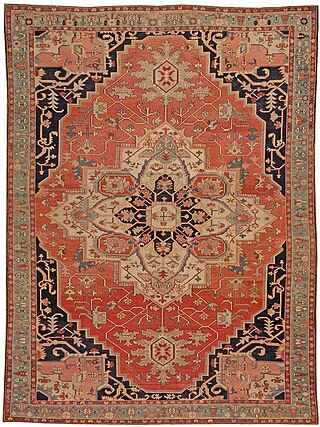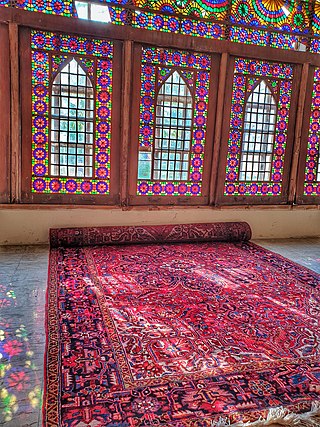
A carpet is a textile floor covering typically consisting of an upper layer of pile attached to a backing. The pile was traditionally made from wool, but since the 20th century synthetic fibers such as polypropylene, nylon, or polyester have often been used, as these fibers are less expensive than wool. The pile usually consists of twisted tufts that are typically heat-treated to maintain their structure. The term carpet is often used in a similar context to the term rug, but rugs are typically considered to be smaller than a room and not attached to the floor.

A Persian carpet or Persian rug, also known as Iranian carpet, is a heavy textile made for a wide variety of utilitarian and symbolic purposes and produced in Iran, for home use, local sale, and export. Carpet weaving is an essential part of Persian culture and Iranian art. Within the group of Oriental rugs produced by the countries of the "rug belt", the Persian carpet stands out by the variety and elaborateness of its manifold designs.

A kilim is a flat tapestry-woven carpet or rug traditionally produced in countries of the former Persian Empire, including Iran, the Balkans and the Turkic countries. Kilims can be purely decorative or can function as prayer rugs. Modern kilims are popular floor coverings in Western households.

Knot density is a traditional measure for quality of handmade or knotted pile carpets. It refers to the number of knots, or knot count, per unit of surface area - typically either per square inch (kpsi) or per square centimeter (kpsc), but also per decimeter or meter. Number of knots per unit area is directly proportional to the quality of carpet. Density may vary from 25 to 1,000 knots per square inch or higher, where ≤80 kpsi is poor quality, 120 to 330 kpsi is medium to good, and ≥330 kpsi is very good quality. The inverse, knot ratio, is also used to compare characteristics. Knot density = warp×weft while knot ratio = warp/weft. For comparison: 100,000/square meter = 1,000/square decimeter = 65/square inch = 179/gereh.

Uşak carpets, Ushak carpets or Oushak Carpets are Turkish carpets that use a particular family of designs, called by convention after the city of Uşak, Turkey – one of the larger towns in Western Anatolia, which was a major center of rug production from the early days of the Ottoman Empire, into the early 20th century.
An oriental rug is a heavy textile made for a wide variety of utilitarian and symbolic purposes and produced in "Oriental countries" for home use, local sale, and export.
Arak rugs, otherwise known as Arak carpets, are made in the province of Arak, Iran. Technically, all rugs from Arak can be considered Arak rugs but those termed Sarouk are marked as of the best quality, while the more general term Arak is used for rugs of lesser quality. Meshkabad used to be the term for the worst quality rugs, but such rugs are now called mahal or Arak. Araks are much more coarsely knotted than the rugs of than Sarouk rugs. Their designs are quite similar, although rather more crudely executed, and often display bold floral medallions set against open fields.

Heriz rugs are Persian rugs from the area of Heris in northwest Iran, northeast of Tabriz. Such rugs are produced in the village of the same name in the slopes of Mount Sabalan. Heriz carpets are durable and hard-wearing and they can last for generations. 19th century examples of such carpets are often found on sale by major auction houses in United States and Europe. Part of the reason for the toughness of Heriz carpets is that Mount Sabalan sits on a major deposit of copper. Traces of copper in the drinking water of sheep produces high quality wool that is far more resilient than wool from other areas. The Heris Carpet is the only carpet in the world where stories of the Old times are woven.

Anatolian rug is a term of convenience, commonly used today to denote rugs and carpets woven in Anatolia and its adjacent regions. Geographically, its area of production can be compared to the territories which were historically dominated by the Ottoman Empire. It denotes a knotted, pile-woven floor or wall covering which is produced for home use, local sale, and export. Together with the flat-woven kilim, Anatolian rugs represent an essential part of the regional culture, which is officially understood as the Culture of Turkey today, and derives from the ethnic, religious and cultural pluralism of one of the most ancient centres of human civilisation.

The Ahar rug, also called Ahar carpet, is a type of Persian carpet made in the town of Ahar in Ahar County is the capital of Karadag Khanate in Iran.

Arthur T. Gregorian,, was a Greater Boston oriental rug dealer and author of books on oriental rugs. He is considered by some to be the world's leading collector of rare, inscribed Armenian rugs.
A Kashmir rug is a hand-knotted oriental rug from Kashmir valley in India, which is associated with Kashmiri handicrafts. Kashmir rugs or carpets have intricate designs that are primarily oriental, floral style in a range of colors, sizes and quality.

Carpets of Middle-Eastern origin, either from Anatolia, Persia, Armenia, Azerbaijan, the Levant, the Mamluk state of Egypt or Northern Africa, were used as decorative features in Western European paintings from the 14th century onwards. More depictions of Oriental carpets in Renaissance painting survive than actual carpets contemporary with these paintings. Few Middle-Eastern carpets produced before the 17th century remain, though the number of these known has increased in recent decades. Therefore, comparative art-historical research has from its onset in the late 19th century relied on carpets represented in datable European paintings.
A Pakistani rug, also known as Pakistani carpet, is a type of handmade floor-covering heavy textile traditionally made in Pakistan and is used for a wide variety of utilitarian and symbolic purposes. Rug/carpet weaving is an essential part of Pakistani culture and Pakistani art.

Armenians wove Lilihans in Lilihan village in what used to be called Kamareh district in Iran. The term Lilihan is better known in the US, in Europe it is not as widely used.

Sultanabad rugs and carpets are floor coverings of distinctive design made in Arak, Iran since the 19th century.
A Sarouk rug is a type of Persian rug from Markazi Province in Iran. Sarouk rugs are those woven in the village of Saruk and also the city of Arak and the surrounding countryside.
The Dilmaghani family, the oldest existing manufacturers of hand knotted carpets and oriental rugs, can be traced back to the 1850s Qajar dynasty, Persia. In an industry which largely produces untitled items often identifiable only by experts, the history and lineage of any name relating to specific types of rugs for so many decades is unusual. Through the 1960s, the Dilmaghani family was still designing, manufacturing and importing Persian carpets from Iran to the United States. Dilmaghani is seen as an important connection of 19th and 20th century Persian rug and carpet production in and around the cities of Tabriz and Kermān. Dilmaghani remained as of 1980 among the best known names of branded hand knotted carpets.

John Bradford Moore (1855–1926) was a trader who established a post at Crystal, New Mexico, at the western end of the Narbona Pass, where he developed the manufacture of Navajo blankets for sale in the United States.
The Bakhtiari rug, along with other weavings, is a major artform of the Bakhtiari tribe, located in Chahar Mahaal and Bakhtiari, Iran. Since the early 19th century, Bakhtiari rugs have been exported around the world.













